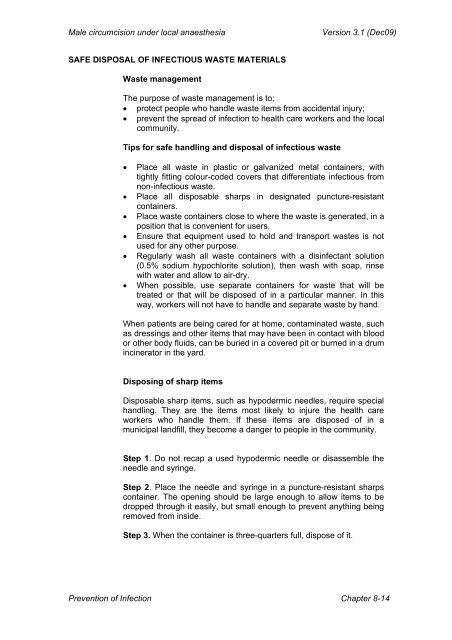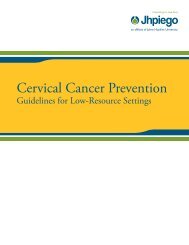Manual for Male Circumcision under Local Anaesthesia
Manual for Male Circumcision under Local Anaesthesia
Manual for Male Circumcision under Local Anaesthesia
Create successful ePaper yourself
Turn your PDF publications into a flip-book with our unique Google optimized e-Paper software.
<strong>Male</strong> circumcision <strong>under</strong> local anaesthesia<br />
Version 3.1 (Dec09)<br />
SAFE DISPOSAL OF INFECTIOUS WASTE MATERIALS<br />
Waste management<br />
The purpose of waste management is to:<br />
• protect people who handle waste items from accidental injury;<br />
• prevent the spread of infection to health care workers and the local<br />
community.<br />
Tips <strong>for</strong> safe handling and disposal of infectious waste<br />
• Place all waste in plastic or galvanized metal containers, with<br />
tightly fitting colour-coded covers that differentiate infectious from<br />
non-infectious waste.<br />
• Place all disposable sharps in designated puncture-resistant<br />
containers.<br />
• Place waste containers close to where the waste is generated, in a<br />
position that is convenient <strong>for</strong> users.<br />
• Ensure that equipment used to hold and transport wastes is not<br />
used <strong>for</strong> any other purpose.<br />
• Regularly wash all waste containers with a disinfectant solution<br />
(0.5% sodium hypochlorite solution), then wash with soap, rinse<br />
with water and allow to air-dry.<br />
• When possible, use separate containers <strong>for</strong> waste that will be<br />
treated or that will be disposed of in a particular manner. In this<br />
way, workers will not have to handle and separate waste by hand.<br />
When patients are being cared <strong>for</strong> at home, contaminated waste, such<br />
as dressings and other items that may have been in contact with blood<br />
or other body fluids, can be buried in a covered pit or burned in a drum<br />
incinerator in the yard.<br />
Disposing of sharp items<br />
Disposable sharp items, such as hypodermic needles, require special<br />
handling. They are the items most likely to injure the health care<br />
workers who handle them. If these items are disposed of in a<br />
municipal landfill, they become a danger to people in the community.<br />
Step 1. Do not recap a used hypodermic needle or disassemble the<br />
needle and syringe.<br />
Step 2. Place the needle and syringe in a puncture-resistant sharps<br />
container. The opening should be large enough to allow items to be<br />
dropped through it easily, but small enough to prevent anything being<br />
removed from inside.<br />
Step 3. When the container is three-quarters full, dispose of it.<br />
Prevention of Infection Chapter 8-14
















